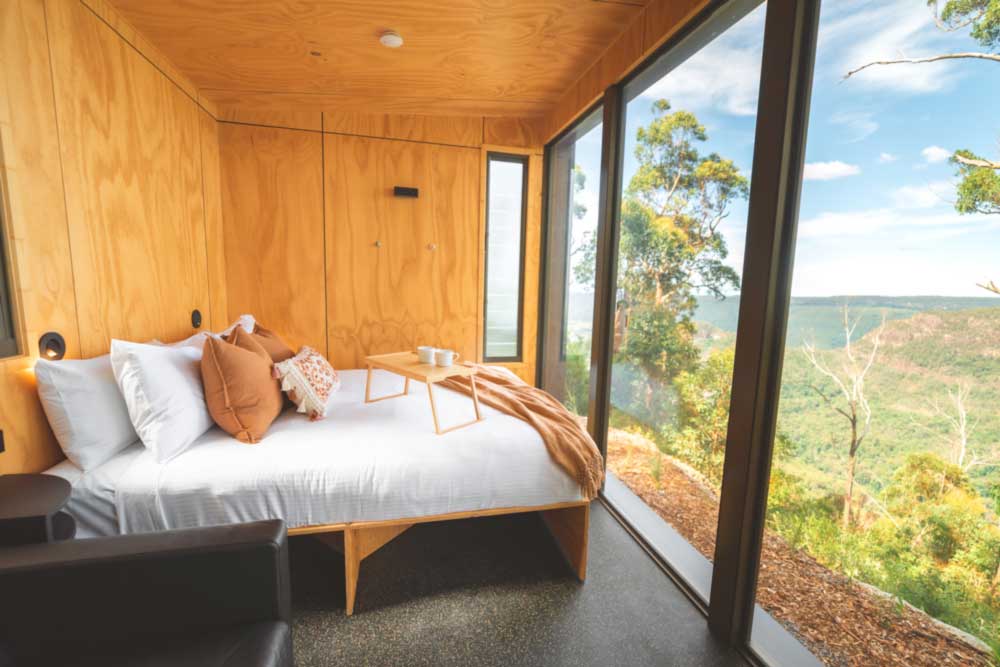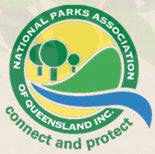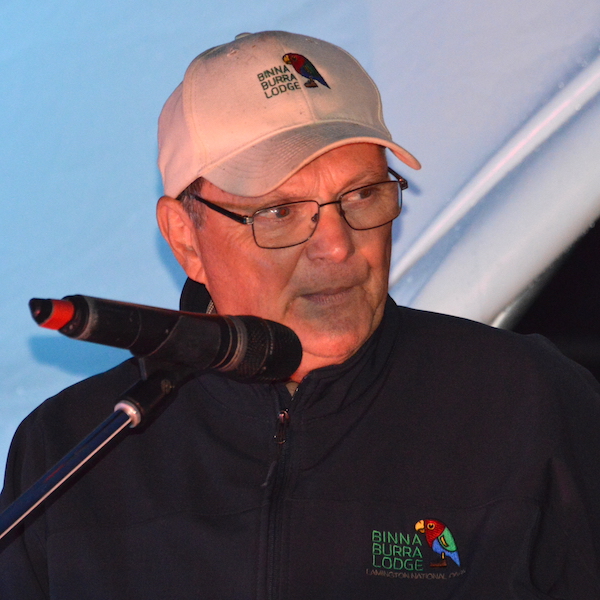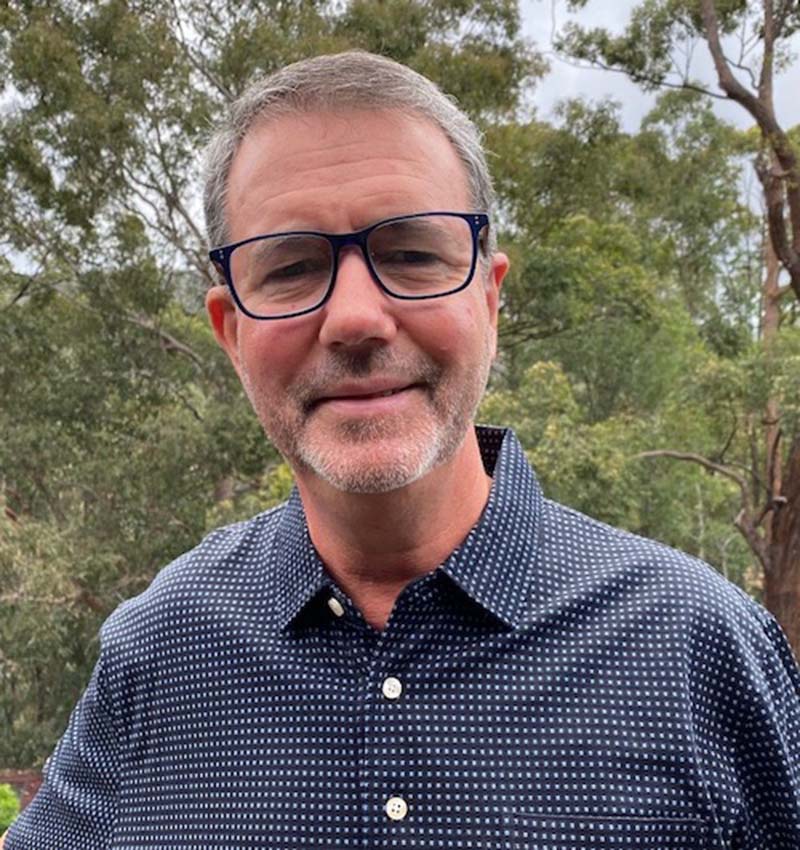About Us
Welcome to Binna Burra, a world-class destination where breathtaking natural wonders await you. We take immense pride in being a cherished heritage-listed destination that offers unforgettable experiences, right here in Woonoongoora, Lamington National Park, Queensland, Australia.
After facing a challenging period when we had to temporarily close our doors for 12 months starting from 8th September 2019 due to devastating bushfires, we are pleased to announce that Binna Burra is back and better than ever.
We can’t wait for you to explore our incredible facilities and accommodation. Get ready to be enchanted by our brand new luxurious Tiny Wild Houses, designed to make you feel right at home amidst nature’s embrace. Our refurbished Safari Tents and campsite offer a cosy and inviting setting for an unforgettable outdoor adventure. Indulge your taste buds at the newly renovated Tea House cafe and restaurant, where delicious cuisine is served in a truly magical atmosphere. And, of course, our famous award-winning luxury Sky Lodge apartments are here to pamper you with unparalleled comfort and sophistication.
Binna Burra invites you to discover the wonders that await in our backyard. Come and experience the warmth, beauty, and friendly hospitality that make us truly special. We can’t wait to welcome you with open arms and share the magic of Binna Burra with you.

We acknowledge and pay respects to the Yugambeh people of the Gold Coast and all their descendants both past and present. We also acknowledge the many Aboriginal people from other regions as well as Torres Strait and South Sea Islander people who now live in the local area and have made an important contribution to the community.
BINNA BURRA LODGE MISSION STATEMENT
To be a meaningful connection to nature and heritage. We attain this by:
- Providing a gateway to Woonoongoora – Lamington National Park.
- Offering a range of eco-friendly accommodation, activities and experiences.
- Nurturing and improving the land and heritage buildings of which we are the custodians.
Positioned 800 metres above sea level amidst the sub-tropical rainforest of Woonoongoora – Lamington National Park in the Gold Coast Hinterland, Binna Burra is centre stage to some of Australia’s most spectacular natural features.
The unique isolation provides the perfect escape from the stresses of every day life and a chance to get back to basics, interact with nature and experience a freedom and sense of peace that few places can offer.
Binna Burra holds the enviable status of being the first Australian property to attain the internationally-recognised Green Globe Certification for its best practice environmental performance, and was listed in the top 10 Eco-Lodges and Green Hotels in the World.
The unique isolation provides the perfect escape from the stresses of every day life and a chance to get back to basics, interact with nature and experience a freedom & sense of peace that few places can offer.

A Rich History
One of Australia’s longest-established nature-based resorts, Binna Burra Mountain Lodge was founded in 1933 by Arthur Groom and Romeo Lahey and others who previously (1930) had formed Australia’s first dedicated conservation organisation, the National Parks Association of Queensland. These two pioneering conservationists shared a vision to create a place where people could stay and experience the beauty of the Lamington National Park rainforest. Through interpretive walks and educational programs, they believed more people would become committed to preserving this natural wilderness for future generations. In the early 1930s, they purchased the last freehold title on the boundary of Lamington National Park and formed a public company to fund the establishment of what was to become Binna Burra Mountain Lodge.
The first Binna Burra camp was held over the Christmas holidays in 1933. Romeo, Arthur and 70 hardy adventurers set up a collection of tents on the “saddle” where the Senses Trail now starts. For five shillings a day, they were provided with accommodation, meals and guided walks through the rainforest. Despite cyclonic storms which ripped through the mountains from Boxing Day until New Year, the camp was declared a success and the decision was made to build permanent cabins on the property.
An old Canungra boarding house (Leighton House) was dismantled and brought up to Binna Burra by packhorse, to serve as the dining and recreation room. For the cabins, tallow-wood slabs and stringy-bark shingles were hewn from the local timber.
By Easter 1934, the first hut was nearly finished and, by 1939, Binna Burra Mountain Lodge could accommodate 54 guests. The road was extended in 1947 to eliminate that last 400m trek and a network of walking tracks provided easier access to the rainforest wilderness. The very first track built was to Bellbird Lookout
Binna Burra quickly became a popular destination with keen bushwalkers of all ages. It also attracted a number of scientists studying the flora and fauna of this living laboratory. Guided, interpretive bushwalks were a feature of the Binna Burra experience even from the earliest days.
After his initial contribution towards construction and track building, Romeo Lahey remained as a director of the company, on and off, until 1960. As resident manager, Arthur Groom lived on site. He and his wife Marjorie and their three sons, Donn, Tony and Richard, lived in the cabin once also used as the LNHA Environmental Study Centre. Nowadays, Groom’s Cottage houses the Binna Burra Bushwalker’s Bar and, upstairs, the Heritage Reading Room.
During the late 60s and early 70s, the Lodge was improved and extended using mostly volunteer labour. The ‘Friends of Binna Burra’ (FOBBs) have continued to make a significant contribution over the ensuing years. Another innovation was the introduction of ‘Vacation Schools’. These included the Wildlife Preservation Society Spring School in 1968, the Creative Arts and Photographic Schools in 1969, and Greenfingers’ Week in 1970. The Lodge still hosts a regular program of Special Interest Events every year.
In 2002, the entire site was designated the Binna Burra Cultural Landscape on the Queensland Heritage Register as a place (a) important in demonstrating the evolution or pattern of Queensland’s history, )b) important because of its aesthetic significance, (c) having a strong or special association with a particular community or cultural group for social, cultural or spiritual reasons and (d) having special association with the life or work of a particular person, group or organisation of importance in Queensland’s history.
On 8 September 2019, at the beginning of six month of ‘Black Summer’ bushfires across Australia, the central heritage lodge and pioneer cabins, as well as other infrastructure was destroyed or damaged. The site was closed for 12 months and reopened for trading with the remaining assets in September 2020.


“Binna Burra to me is more than home. It is more than a lifetime commitment. It is a feeling, a spirit, a way of life. It is also a sum of all those who have worked there or stayed as a guest. My hope is that an unchanged Binna Burra, the place and the spirit, will outlive me and my children.”

Marjorie Groom (1911-1998) with Richard Groom, Donn Groom & Tony Groom. Photo circa 1940s.
OUR COMMITMENT TO SUSTAINABILITY
Sustainability Overview
Binna Burra’s Board and staff are fully committed to implementing and demonstrating effective sustainable management. We have been doing this since the company was first formed in the 1930s, and over the past 20 years, we have pioneered many practices which are now part of international sustainable tourism guidelines.
We aim to achieve the international standards for sustainable tourism laid out by the Global Sustainable Tourism Council (GSTC) in order to ensure our business operations:
- Maximise social and economic benefits to the local community and minimize any negative impacts
- Maximise benefits to our cultural heritage and minimise any negative impacts
- Maximise benefits to our world heritage listed natural environment and minimise negative impacts
As an example, by designing and adopting site-specific best practice procedures as detailed in the Lodge’s Environmental Management Plan (EMP), Binna Burra has dramatically reduced its environmental impacts and has also benefited financially from the reductions in energy usage.
This effort was so significant that Binna Burra Mountain Lodge first earned Green Globe Certification in 2001. In doing so, Binna Burra was also the first private company in Australasia to achieve certification under the international Green Globe standards for sustainable tourism practices.
Prior to and since its certification, Binna Burra had been recognised by a variety of environmental, ecotourism and tourism organisations. In 2018 during the annual conference of Ecotourism Australia held in Townsville, Binna Burra was one of a handful of Australian tourism enterprises recognised for 20 consecutive years of maintaining its ecotourism certification.


Binna Burra Lodge Ltd has committed to benchmarking its energy and water consumption, total waste production and community commitment; along with implementing an integrated environmental and social policy.
The GSTC establishes and manages global sustainable standards, known as the GSTC Criteria. These are the guiding principles and minimum international requirements that any tourism business or destination should aspire to reach in order to protect and sustain the world’s natural and cultural resources while ensuring tourism meets its potential as a tool for conservation and poverty alleviation.
“Binna Burra Lodge has had what we now call a sustainable approach to tourism since its inception in 1933 when the concept of national parks was still new around the world.
Nowadays we also have the framework of world heritage values. This results in Binna Burra Lodge sharing responsibility for conservation of our cultural and natural heritage through sustainable tourism management.”

Acknowledging the earliest inhabitants at Binna Burra
A statement of information and policy endorsed by the Board of Directors, Binna Burra Lodge Limited, 18 December 2017.
‘Lamington National Park’s earliest human inhabitants were an Aboriginal kinship group, the Yugambeh who lived in this area, carefully managing and using its rich natural resources. Known as ‘Woonoongoora’ to the Yugambeh, the mountains are sacred and spiritual, places to be nurtured and respected.’
Dept of Environment and Science (DES)
As a business that operates within a World Heritage designated natural environment, Binna Burra Lodge Limited’s vision ‘To be a meaningful connection to nature and heritage’ is delivered with the identification, protection, conservation, presentation and transmission to future generations of the cultural and natural heritage of our location.
We acknowledge and respect that the land upon which Binna Burra is located was used by traditional ‘first nations’ people of this mountain area.
While some people may see Acknowledgement and Welcome to Country as a recent practice invented for the sake of political correctness, or an empty token gesture, Wurundjeri Elder, Joy Murphy Wandin, describes it as “a very important way of giving Aboriginal people back their place in society, and an opportunity for us to say, ‘We are real, we are here, and today we welcome you to our land’…It’s paying respect, in a formal sense, and following traditional custom in a symbolic way.”
https://australianstogether.org.au/resources-2/welcome-to-and-acknowledgement-of-country/
Lamington Natural History Association (LNHA)

In 1975 the Lamington Natural History Association (LNHA) was formed, in association with Binna Burra Mountain Lodge, O’Reilly’s Rainforest Guesthouse and the Queensland National Parks and Wildlife Service.
LNHA was based on a concept which was common in the USA in the early 1970s, but was the first of its type in Australia. One of the Association’s early major projects was the establishment of an environmental study centre and headquarters on the Binna Burra property by renovating the timber cabin which Arthur Groom had built for himself and his wife in 1935. Opened in 1976, the centre contained an office, class-room, and dormitory accommodation for children taking part in educational camps (Stubbs & Specht, 2005).
The aim of LNHA is, to encourage an understanding and appreciation of the environment and national park values and provide interpretative information for visitors to Lamington National Park.
It does this by:
• Accredited members assisting the Queensland Parks and Wildlife Service (QPWS) by volunteering in the Binna Burra Information Centre on weekends and school holidays
• The LNHA provides interpretive information to visitors to Lamington National Park through, Books Track Guides and Brochures
• Activities for Members and guests on four weekends per year
• Guest speakers provide specialist talks on topics relating to Natural History, the environment and Lamington National Park
National Parks Association of Queensland (NPAQ)
 Back in 1930, the pioneering founders of Binna Burra, Romeo Lahey and Arthur Groom were also instrumental in the founding of the NPAQ.
Back in 1930, the pioneering founders of Binna Burra, Romeo Lahey and Arthur Groom were also instrumental in the founding of the NPAQ.
It was out of the NPAQ and its increasingly popular camp-outs that the idea of establishing low-cost but comfortable accommodation which would allow a greater number of people to gain access to the peace, freedom and beauty of Queensland’s national parks emerged, and Binna Burra was established in 1933. The association continues to promote the preservation, expansion and good management of national parks and other forms of protected areas in Queensland.
‘During the early years of Binna Burra, (Romeo) Lahey also marked out and began construction of walking tracks within Lamington National Park, laying the foundation of the extensive network of tracks in the park today.’ (Stubbs & Specht, 2005)
NPAQ is an independent, not-for-profit, membership-based organization, and is the first conservation organisation in Queensland, and the longest running National Park Association in Australia.
Nowadays, Binna Burra still shares the objectives of NPAQ:
1) To preserve the National Parks and other protected areas of Queensland in their natural condition, to the greatest possible extent, and to endeavour to ensure the reservation and preservation of other areas considered to be suitable for protection;
2) To foster member and public interest in, enjoyment of, and respect for National Parks and nature conservation;
3) To promote the appropriate management of National Parks and other protected areas, and appropriate management of environmental factors which may affect existing and potential National Parks;
4) To promote effective legal and environmental protections in respect of National Parks and other protected areas, and to ensure the enforcement of provisions for their protection;
5) To promote appropriate and balanced measures for visitors to experience National Parks while conserving and protecting the natural environment.
Binna Burra Board of Directors:

Steve Noakes
Chairperson
- Local Beechmont/Binna Burra resident
- Extensive 45 years of engagement in the tourism and travel sector as an entrepreneur, academic and volunteer in various not-for-profit organisations
- Former Vice President & Councillor, National Parks Association of Queensland
- Received (2008) the inaugural Ecotourism Australia Medal, recognizing active engagement in the Australian and international ecotourism industry
- Tertiary qualifications in business, tourism, hospitality and teaching
- Has served as an Adjunct Professor in Sustainable Tourism at Universities in Australia, Finland and Norway

Hal Morris
Director
- In April 2020, Hal Morris was invited to re-join the Board of Binna Burra after the September 2019 bushfires.
- Previously been Chairman of Binna Burra for eight years from 2007 to 2015
- CEO of the Gold Coast Waterways Authority 2013 - 2021
- Graduated from the Royal Military College, Duntroon in 1981
- Has held senior executive roles in the Queensland Public Service and Queensland Rail
- Past CEO of the Australian Logistics Council then the Chartered Institute of Logistics and Transport (Australia)
- Tertiary qualifications in Government and Business

Helen Moore
Director
- Chair of the Binna Burra Lodge Ltd Board Committee on Audit & Risk
- Former General Manager Finance and Business Services, Gold Coast 2018 Commonwealth Games Corporation (2012 – 2018)
- Independent Chair of Audit and Risk Management Committee, Queensland Department of Education
- Independent Chair of Audit, Finance and Risk Management Committee, Trade and Investment Queensland
- Independent Chair of Audit and Compliance Committee, Local Government Association of Queensland
- Independent Member of Audit and Risk Committee, Indigenous Land and Sea Corporation
- Independent Member of Finance, Audit and Risk Management Committee, National Centre of Indigenous Excellence
- Independent Member of Audit, Risk and Compliance Committee, Great Barrier Reef Foundation
- Independent Member of Audit and Risk Committee, City of Moreton Bay Council
- External Member of Audit, Risk and Finance Committee, CQUniversity
- Non-Executive Director of Santos Organics Ltd and Chair of Audit Committee
- Tertiary qualifications in Business/Accounting, Fellow of CPA and Graduate of AICD

Rachel Brown
Director
- Managing Director & Company Secretary, RE Brown Consulting. Advisory services to property and agricultural family businesses.
- Board member Caloundra City School Limited
- Previous experiences include:
- Director & Company Secretary & Risk Committee member, McIntyre Centre Riding for the Disabled Ltd
- Secretary/Treasurer, Brisbane Triathlon Club
- Experienced commercial lawyer in utilities, property and FMCG sector
- Graduate Member, Australian Institute of Company Directors
- Chartered Secretary, Governance Institute of Australia
- Bachelor of Economics and Bachelor of Law

Gary Grant
Director
- Member of Binna Burra Lodge Audit and Risk Committee
- Member of Binna Burra Lodge Design Committee
- Managing Director, Grant Management Consultants.
- Former Director-WHS & Risk - Cross River Rail Delivery Authority
- Former Principal and Global Safety/Crisis Manager - Advisian, part of Worley Group
- Former General Manager-Training and National HSE Manager - Chubb Fire Safety
- Former State Training Officer - NSW State Emergency Service, and member of NSW State Rescue Board Training Advisory Panel
- Former Senior Constable & Senior Rescue Instructor, NSW Police Force
- Tertiary qualifications in OHS, Criminal Justice and Training
- Commissioner of Declarations
- Certified Generalist OHS Practitioner-Australia Institute of Health and Safety

Robert McDowall
Director & Company Secretary
- Managing Director, Arabon Accountant
- Chair and Non-Executive Director, Hard Fizz
- Company Secretary, BALNCE Group
- Fellow, CPA Australia
- Former Deputy President of Queensland Divisional Council, CPA Australia (2019)
- Regular contributor to CPA Australia committees and programs
- Graduate Member, Australian Institute of Company Directors
- Justice of the Peace (Qualified)
- Bachelor of Commerce (Accounting), undertaking Masters of Teaching (Secondary)
